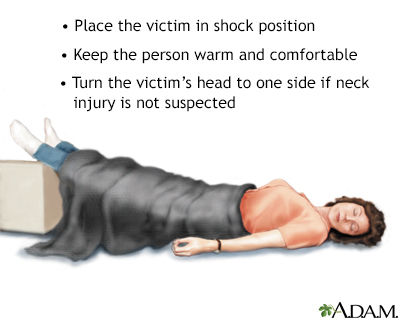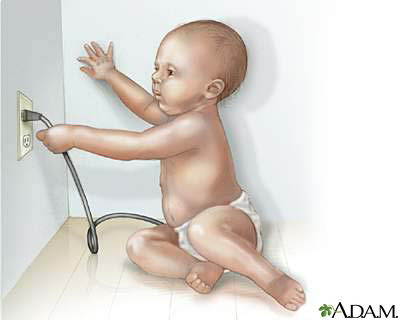Electric scooter injuries on the rise
Electric scooters have become a staple of many urban environments. They’re convenient, nimble — and behind a surprising surge in injuries. Researchers at the University of California San Francisco...
Update your location to show providers, locations, and services closest to you.
An electrical injury is damage to the skin or internal organs when a person comes into direct contact with an electrical current.
Electrical shock
The human body conducts electricity very well. That means electricity passes very easily throughout the body. Direct contact with electrical current can be deadly. While some electrical burns look minor, there still may be serious internal damage, especially to the heart, muscles, or brain.
Electric current can cause injury in four ways:
Electrical injury can be caused by:
Symptoms depend on many things, including:
Symptoms may include:
1. If you can do so safely, turn off the electrical current. Unplug the cord, remove the fuse from the fuse box, or turn off the circuit breakers. Simply turning off an appliance may NOT stop the flow of electricity. Do NOT attempt to rescue a person near active high-voltage lines.
2. Call your local emergency number, such as 911.
3. If the current can't be turned off, use a non-conducting object, such as a broom, chair, rug, or rubber doormat to push the person away from the source of the current. Do not use a wet or metal object. If possible, stand on something dry that doesn't conduct electricity, such as a rubber mat or folded newspapers.
4. Once the person is away from the source of electricity, check the person's airway, breathing, and pulse. If either has stopped or seems dangerously slow or shallow, start first aid.
5. CPR should be started if the person is unconscious and you can't feel a pulse. Perform rescue breathing on a person who is unconscious and not breathing or is breathing ineffectively.
6. If the person has a burn, remove any clothing that comes off easily and rinse the burned area in cool, running water until the pain subsides. Give first aid for burns.
7. If the person is faint, pale, or shows other signs of shock, lay them down, with the head slightly lower than the trunk of the body and the legs elevated, and cover him or her with a warm blanket or a coat.
8. Stay with the person until medical help arrives.
9. Electrical injury is frequently associated with explosions or falls that can cause additional severe injuries. You may not be able to notice all of them. Do not move the person's head or neck if the spine may be injured.
10. If you are a passenger in a vehicle struck by a power line, remain in it until help arrives unless a fire has started. If necessary, try to jump out of the vehicle so that you do not maintain contact with it while also touching the ground.
Call your local emergency number, such as 911, if a person has been injured by electricity.


Cooper MA, Andrews CJ, Holle RL, Blumenthal R, Aldana NN. Lightening-related injuries and safety. In: Auerbach PS, Cushing TA, Harris NS, eds. Auerbach's Wilderness Medicine. 7th ed. Philadelphia, PA: Elsevier; 2017:chap 5.
O'Keefe KP, Semmons R. Lightning and electrical injuries. In: Walls RM, Hockberger RS, Gausche-Hill M, eds. Rosen's Emergency Medicine: Concepts and Clinical Practice. 9th ed. Philadelphia, PA: Elsevier; 2018:chap 134.
Ryan CM, Goverman J, Friedstat J, Price LA. Electrical injury and lightning injury. In: Cameron AM, Cameron JL, eds. Current Surgical Therapy. 13th ed. Philadelphia, PA: Elsevier; 2020:1312-1317.
Sheridan RL. Medical Aspects of Trauma and Burns. In: Goldman L, Schafer AI, eds. Goldman-Cecil Medicine. 26th ed. Philadelphia, PA: Elsevier; 2020:chap 103.

Electric scooters have become a staple of many urban environments. They’re convenient, nimble — and behind a surprising surge in injuries. Researchers at the University of California San Francisco...